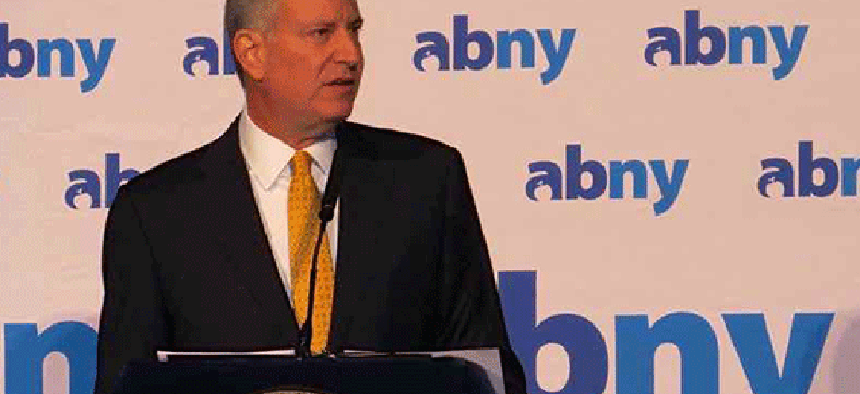De Blasio Unveils New Strategy To Reduce Street Homelessness

In a speech to New York City’s business leaders, Mayor Bill de Blasio declared that his administration had made progress on improving the everyday experience of New Yorkers, but also pledged to redouble his efforts to reduce street homelessness through greater outreach and enforcement of “quality of life” laws.
“There’s been progress on all of the basics like filling the potholes and repaving the roads. And progress on the big initiatives like affordable housing and improving our schools,” de Blasio told the crowd at today's Association for a Better New York Breakfast in Midtown Manhattan. “There’s a lot more to do when it comes to quality of life, and one issue that has been a persistent challenge not just for years, but for decades, and affects the quality of life for all of us and undermines the foundations of the lives of those afflicted – the issue of homelessness – must be addressed.”
De Blasio also debuted his Homeless Outreach and Mobile Engagement Action Team, or HOME-STAT, at the event. With a name evoking the digital crime statistics tracking tool CompStat, HOME-STAT will compile information on every homeless person on the street in a central hub overseen by police, Department of Homeless Services and personnel at other human services agencies.
As part of the city-funded initiative, teams will canvass every block between Canal Street and 145th Street in Manhattan as well as targeted areas in the other boroughs.
Conditions reported from the field will be used to update HOME-STAT - and its public dashboard – and to allocate resources. In tandem, the mayor committed to having either the New York City Police Department or Department of Homeless Services staff on scene within an average of an hour when people report a homeless person anywhere in the city, including the subway system.
The mayor took pains to say his administration would both aggressively enforce laws and take a compassionate approach by treating mental illness, substance abuse and other underlying conditions of homeless people. If a report suggests an infraction, police trained to deal with street homeless will respond. If not, Homeless Services personnel will be sent, the mayor said.
Every person living on the streets will be assigned a caseworker, who will craft an individual action plan for the person. By the time HOME-STAT is fully operational in March, the city says its outreach staff will have grown from 175 to 312 and about 110 specially trained police officers will be involved with the initiative. Funds and staff have been shifted to focus on HOME-STAT, the administration said.
“It is illegal to harass New Yorkers,” de Blasio said. “It is illegal to use drugs. It is illegal to erect a makeshift shelter. It is illegal to urinate in public. … Whether someone is homeless or not homeless, if they violate our quality of life laws, the NYPD will enforce those laws.”
“It’s not illegal to sit out in the cold weather on your own 24 hours a day, but that doesn’t make it right; that doesn’t make it good,” he added. “So the best thing for New Yorkers living on the streets – the best thing for the communities around them -is to help them get off the streets and rebuild their lives.”
De Blasio said his staff estimated there were between 3,000 and 4,000 living on the street. Under HOME-STAT, his administration will be conducting quarterly nighttime counts of this population and crafting monthly reports on conditions, outcomes and other performance measures. This comes after homeless advocates and nonprofit partners said lack of solid data limited how much government funding they were eligible for.
The mayor acknowledged that some living on the street were resistant to using a homeless shelter and receiving medical care and other basic services, but he said outreach personnel were prepared to approach such individuals until “we find the thing that works.” He was careful to contrast this with the population living in shelters. De Blasio said there were more families and working people in such facilities, and various rental assistance programs, anti-eviction legal efforts and affordable housing initiatives were moving this population towards more stable conditions.
His message was well-received by a number of elected officials, human service providers and business executives.
“The NYPD's Compstat model is an innovative, problem solving tool that police agencies have implemented across the nation, so it makes perfect sense that HOME-STAT will leverage those same problem solving strategies to address street homelessness outreach efforts," John Banks, president of The Real Estate Board of New York, said in a statement.
De Blasio’s speech comes after New York City Council Speaker Melissa Mark-Viverito and others’ efforts to decriminalize quality of life offenses such as drinking in public or cycling on the sidewalk. Mark-Viverito spokeswoman Robin Levine said the City Council has long prioritized fighting homelessness and would review the mayor’s plan. But some advocacy groups, including Picture the Homeless, which is based in Mark-Viverito’s district, seemed miffed by the self-described progressive’s pitch.
“More case workers, more cops – that does nothing for me,” Jesus Morales, a member of Picture the Homeless who has lived on the street for more than 15 years, said in a statement issued by the group. “People walk by me all day, every day, with big bags full of holiday shopping. Cops don't say anything to them. To me, the cops say, "Why do you have all these bags? These bags have got to go.’ And they seize them, throw them away. They need to help the homeless with something real – a place, a home, not a shelter.”